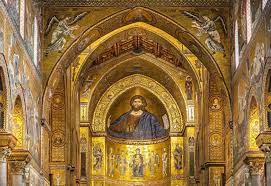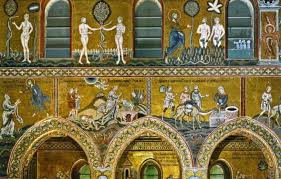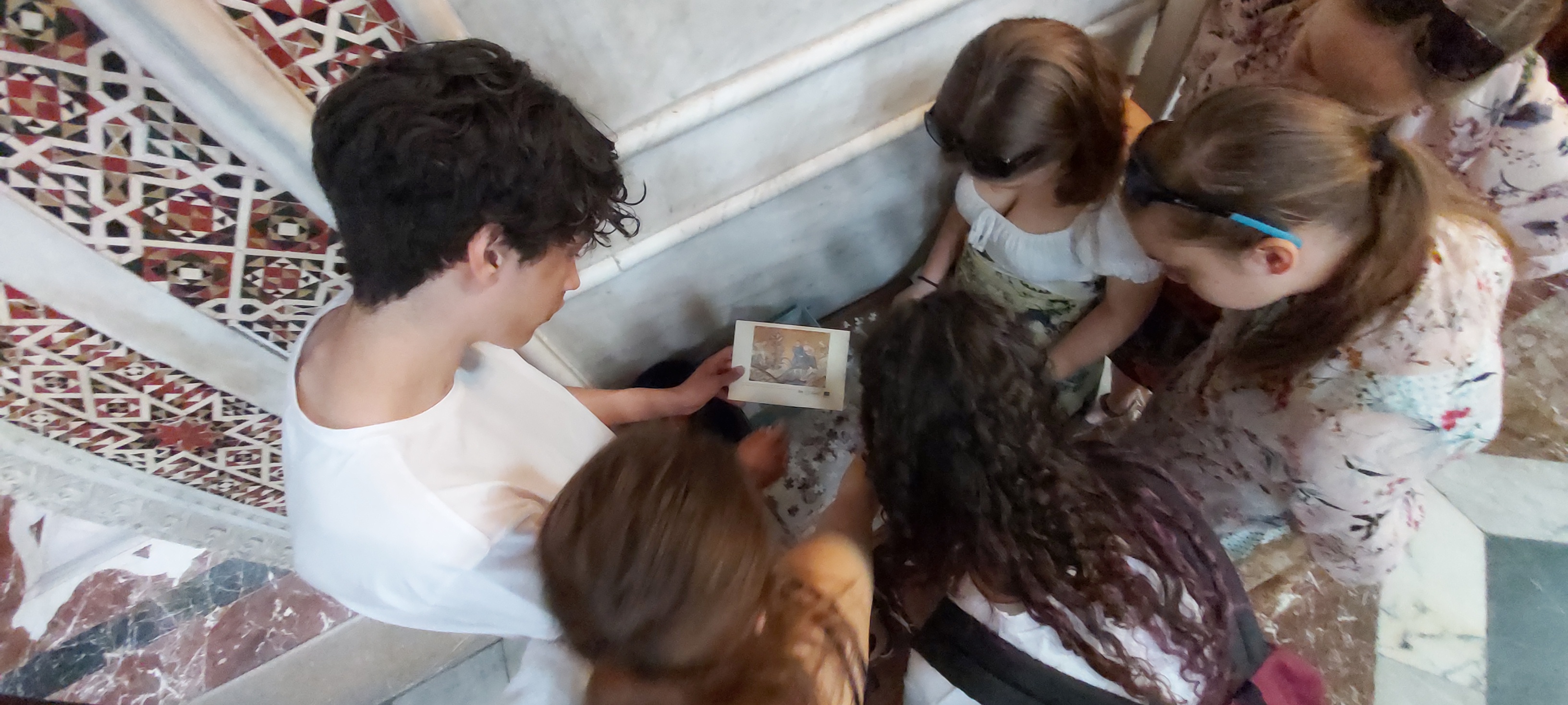Arts miniMOOC: Museums sources for teaching Art history and Botanic Science
Topic outline
-
The origins of the Arts MiniMOOC "The tree of Paradise"
Organisers and creators of this MiniMOOC:The tree of Paradise are
Renata Colomba & Roberta Accardi, Teachers in Liceo Scientifico S. Cannizzaro, Palermo, Italy
Renata Colomba is a History and Philosophy teacher and Roberta Accardi is an Italian Literature and Latin teacher; they both like fine art, history and working together in an international environment.

Goals of the MiniMOOC
The project, in the perspective of a STEAM methodology, aims to innovate the curricular activity throughout the interaction of different subjects: History, Art and Science (Biology- Botanic). It aims at the recovery of fundamental values for our culture and for our territory and to relate pre scientific wisdom, expressed through the strong symbolic value of art, and today’s scientific approach, in order to overcome the rigid division between humanistic and scientific knowledge.
Depictions of nature can be about intellectual thought and spirituality. Art involving nature can be done simply to display the beauty of the natural world around us, to make scientific observations in an environment, or to open our minds to philosophical ideas about our own connection to nature and beyond *.
A Museum is a building in which objects of historical, scientific, artistic, or cultural interest are stored and exhibited, therefore the Monreale Cathedral in Palermo - Sicily, can be visited as a Museum too. The starting point of this project is the study of the medieval Cathedral of Monreale, one of the greatest existing examples of Norman architecture, a synthesis of extraordinary knowledge and culture. The unit deals with the historical context, the artistic styles expressed in the precious Byzantine mosaics full of symbolism and also of representations linked to aspects of daily life (clothing and presence of agricultural landscapes).
-
From here begins the observation of the botanical species represented in the mosaics, with a strong symbolic value but also typical of a Mediterranean environment: the fig, the palm, the vine. In particular, students will be invited to recognize them and then to reconnect them to the survival of this environment today and to the analysis of its characteristics.
The symbology expresses an ancient wisdom of the world, pre-scientific, but still based on the observation of the characteristics and value that the natural environment keeps for mankind.
Can the ancient wisdom of nature, also expressed through symbolism, still say something to us contemporaries?
This topic can also be re-proposed in other contexts, starting from differences in iconographic representations.
The activity also allows the students to develop several skills :
✔ soft skills : Integrated skills activity; to analyze and discuss; collaboration, presenting results, creativity, communication in English, time management, etc.
✔ hard skills : to recognize and explain people's different ideas through artistic representation (knowledge and beliefs); to introduce the class to the artistic technique of mosaic and to understand the symbolic language; to analyze plants and to highlight the important aspects of them for the society; to compare the value of nature in the past, through art, and in the present.
The main goal is to compare and discuss two different approaches to nature expressed in art and science: a pre scientific vision, expressed through the strong symbolism in art, and today’s scientific approach, in order to overcome the rigid division between humanistic and scientific knowledge.
Can the ancient wisdom of nature, also expressed through symbolism, still say something to us contemporaries? Pupils will express their ideas in a multimedia product.

-
Please self-create an account if you want to post something - we would appreciate any comments of suggestions or questions (just note that project ended in August 2022 and it may take time for us to respond).
-
The goal in this part is to introduce the MiniMOOC to the participants with a general introduction to the course and a launching activity.
It will be the spectacular context of the cathedral that will arouse curiosity in the students. We will refer to previous knowledge on the Norman period in Sicily, inviting the pupils to trace aspects of the Norman, Arab and Byzantine cultures in the cathedral. Pupils, while moving around, will have 10 minutes to observe and recognize the aspects. The observations will be shared, checked and discussed. They will be reported in an observation sheet of the monument.
The task: In pairs, move around the Cathedral and trace 3 elements from Norman culture, 3 from Arabic and 3 from Byzantine. You have 10 minutes to observe and take photos of what you consider relevant. After that, we will all meet together again to share and discuss. Using the smartphone, create a short video – photo gallery with 3 sections (Latin, Arabic and Byzantin elements) with the pictures taken in the Cathedral. Share it with the class.
-
Only registered users can provide feedback, so if you would like to provide it, please create an account in the login page (top right of the page)
-
-
In the second phase of exploration, the group will discover the plants represented in the mosaics (vine plant, fig, palm, tree of life) and the landscapes in which they are inserted. After that, they will be invited to search on the web or they will be supported by the teacher to understand the symbolic value attributed to these plants in ancient times. They will work in a group and they will share their results that will be reported in a text. A question could be: what kind of leaves Adam and Eve used to cover themselves?
Finally, the pupils will be invited to make a personal sketch of a detail of the botanical representations or to recompose the parts of a puzzle representing a scene from the mosaics, working in a group. The final activity will strengthen the spirit of observation and the emotional aspect aroused by the artistic fruition.

-
Only registered users can provide feedback, so if you would like to provide it, please create an account in the login page (top right of the page)
-
Explain : How do they work ? (60 m)
In this section at school, pupils are provided with a Botanic laboratorial lesson .
In the biology laboratory, with the teacher's guidance, the leaves of the plants will be analyzed and the teacher will illustrate their main characteristics, also in relation to the natural environment in which they grow. Through research on the net, the fundamental properties and geographical spread will be investigated. A specific analysis sheet will be provided. The online research will be carried out in pairs. (Appendix 1 and Appendix 2)
Instructions for the task :
Observe the leaves provided following the guided lesson; try the experiments and then research in the net about their habitat and their use in life.
-
-
A tool to observe and to analyze the parts of the leaves and the way how they work with some experiments to run.
-
Only registered users can provide feedback, so if you would like to provide it, please create an account in the login page (top right of the page)
-
-
Art and Science : Can they talk to us? (30min)
Symbology expresses an ancient wisdom of the world, pre-scientific, but still based on the observation of the characteristics and value that the natural environment has for mankind.
Can the ancient wisdom of nature, also expressed through symbolism, still say something to us contemporaries? They discuss together.
Extend the research to some other artistic works (research online or provided by the teacher) that uses the same symbolism, capturing similarities and differences.
Pupils will illustrate the work in a multimedia product entitled "The tree of Paradise".
To learn more:
-
Only registered users can provide feedback, so if you would like to provide it, please create an account in the login page (top right of the page)
-
Students are provided with a self-evaluation questionnaire (attached below) to test themselves and the activity as well. The aim is to make the students able to express their general impression. Particularly, questions from 1 to 6 are related to what they learned; questions from 7 to 16 are related to the different skills developed; questions from 17 to 19 are related to the satisfaction and improvement suggested by the students.
The same aspects are checked by an evaluation grid based on the teacher observation (also attached below).
-
Two different grids to evaluate the activity: one for the students and one to guide teachers observation on their students.
-
Only registered users can provide feedback, so if you would like to provide it, please create an account in the login page (top right of the page)
-
-
Presentation of the methodology used to create the MiniMOOC
-
Let's talk about your impressions about the museums
-